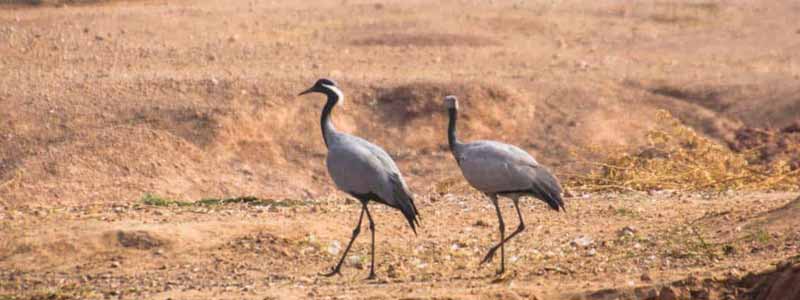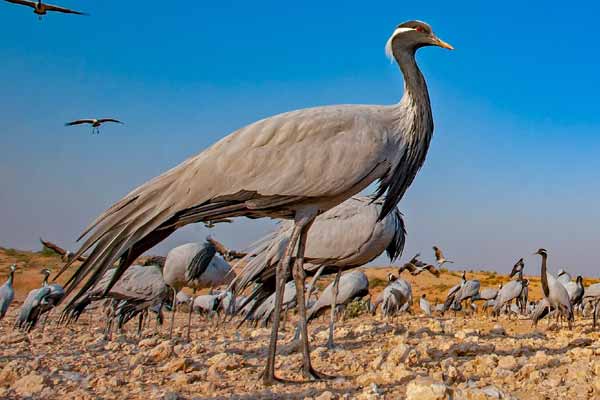Khichan Village, a small village in Rajasthan’s Jodhpur district, is globally renowned for its harmonious relationship with the migratory Demoiselle cranes, locally called Kurja. Every winter, thousands of these elegant birds travel over 5,000 kilometers from Eurasia and Siberia to seek refuge in this desert haven.
The village’s unique tradition began in the 1970s when a local resident started feeding a small flock of cranes. Today, this act of kindness has evolved into an organized effort, with the Chugga Ghar (feeding house) serving as a safe space where villagers provide grains for the birds. The sight of these majestic creatures gathering in unison is a spectacle that attracts birdwatchers and photographers from across the globe.
Khichan is also a hub for ecotourism, blending wildlife conservation with traditional Rajasthani hospitality. Its iconic havelis, desert landscapes, and nearby attractions like Phalodi and Osian enrich the visitor experience. A testament to the coexistence of nature and humanity, Khichan Village inspires awe and conservation alike.

A Glimpse into Khichan’s History and Culture
Khichan is a traditional Rajasthani village with a population deeply rooted in agriculture and trading. Predominantly inhabited by the Jain community, the village reflects the Jain values of non-violence and compassion towards all living beings. These principles have significantly influenced the locals’ attitude toward wildlife, culminating in their extraordinary relationship with the Demoiselle cranes, locally known as kurja.
The transformation of Khichan into a bird sanctuary began in the late 20th century when a few migratory cranes were fed by the villagers. Over time, this feeding practice grew into a large-scale operation that now attracts tens of thousands of these graceful birds every winter, Khichan Village.
The Phenomenon of the Demoiselle Cranes
Demoiselle cranes, the smallest and one of the most elegant crane species, undertake a perilous migration across the Himalayas to reach Khichan Village from their breeding grounds in Eurasia. They travel thousands of kilometers, navigating extreme weather conditions and treacherous terrains. The reward for their arduous journey is the warm hospitality of Khichan’s residents.
From November to March, the village becomes a sanctuary for these migratory birds. At dawn, flocks of cranes arrive at designated feeding grounds, known as chugga ghar, where they are fed grains by the villagers. This daily ritual is a sight to behold, with thousands of cranes gracefully landing and interacting in a symphony of movement and sound. The spectacle attracts photographers, ornithologists, and tourists from around the globe.
Conservation and Community Involvement
The remarkable relationship between the villagers and the cranes is not accidental but a result of sustained conservation efforts. Decades ago, a local philanthropist began feeding a few cranes out of compassion. This gesture resonated with the community, and soon, the practice became a collective effort.
Villagers contribute both time and resources to ensure the birds are well-fed. They set aside parts of their harvest and pool funds to buy additional grains, particularly millet, to feed the growing number of cranes. The feeding ground, chugga ghar, is maintained meticulously to provide a safe and hygienic environment for the birds Khichan Village.
Khichan’s conservation model is unique because it is entirely community-driven. Unlike many wildlife conservation projects that rely on external funding or government intervention, the efforts in Khichan are rooted in the villagers’ cultural and ethical values.
Tourism and Its Impact
Khichan’s rise to fame as a bird-watching destination has brought significant economic opportunities to the village. Tourists flock to the village during the winter months to witness the crane congregation, bringing revenue to local businesses. Homestays, guesthouses, and small eateries cater to visitors, offering them a glimpse of traditional Rajasthani hospitality.
However, the influx of tourists also presents challenges. Increased human activity can disturb the birds, and the village’s infrastructure needs to keep pace with the growing number of visitors. To address these issues, the community has adopted measures to ensure sustainable tourism, such as regulating access to feeding areas and educating visitors about the importance of maintaining a respectful distance from the birds.
Best Time to Visit Khichan Village
The best time to visit Khichan Village is during the winter months, from November to February. This period marks the arrival of the migratory Demoiselle Cranes, which flock to the village in large numbers. The sight of thousands of these elegant birds feeding in the open fields is a spectacular experience for birdwatchers and nature lovers.
Visiting during these months also offers pleasant weather, with daytime temperatures ranging from 15°C to 25°C, making it ideal for outdoor activities. The early mornings, when the cranes gather for feeding, provide the most captivating views.
Though Khichan Village can be visited year-round, the peak bird migration season in winter is when the village truly comes alive, offering the best opportunity to witness the harmonious relationship between the villagers and the cranes.
How to Reach Khichan Village
Khichan, located in the Phalodi tehsil of Jodhpur district in Rajasthan, is well-connected by road, rail, and air. Here’s how you can reach this serene bird haven:
By Air
The nearest airport is Jodhpur Airport, approximately 150 kilometers from Khichan. Jodhpur is well-connected to major Indian cities like Delhi, Mumbai, and Jaipur. From the airport, you can hire a taxi or take a bus to Khichan. The drive takes around 2.5 to 3 hours.
By Train
The closest railway station is Phalodi Junction, located about 8 kilometers from Khichan. Phalodi has regular train services connecting it to Jodhpur, Bikaner, and other major cities in Rajasthan. From Phalodi, you can hire a taxi or take an auto-rickshaw to reach the village.
By Road
Khichan is easily accessible via National Highway 11, which connects it to major towns and cities. Regular buses operate between Phalodi and Khichan. For a more comfortable journey, you can hire a private taxi from Jodhpur, Bikaner, or nearby cities.
Plan your visit during the winter months for the best experience, as this is when the Demoiselle Cranes arrive in large numbers.
